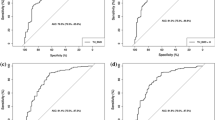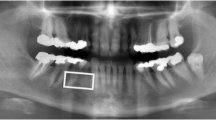Abstract
Summary
Twenty-one excised femurs were studied using (1) a high-resolution digital X-ray device to estimate three textural parameters, (2) dual-energy X-ray absorptiometry (DXA) to measure bone mineral density (BMD), and (3) mechanical tests to failure. Textural parameters significantly correlated with BMD (p < 0.05) and bone strength (p < 0.05). Combining texture parameters and BMD significantly improved the fracture load prediction from adjusted r 2 = 0.74 to adjusted r 2 = 0.82 (p < 0.05).
Introduction
The purpose of this study is to determine if the combination of bone texture parameters using a new high-resolution X-ray device and BMD measurement by DXA provided a better prediction of femoral failure load than BMD evaluation alone.
Methods
The proximal ends of 21 excised femurs were studied using (1) a high-resolution digital X-ray device (BMA™, D3A Medical Systems) to estimate three textural parameters: fractal parameter Hmean, co-occurrence, and run-length matrices, (2) DXA to measure BMD, and (3) mechanical tests to failure in a side-impact configuration. Regions of interest in the femoral neck, intertrochanteric region, and greater trochanter were selected for DXA and bone texture analysis. Every specimen was scanned twice with repositioning before mechanical testing to assess reproducibility using intraclass correlation coefficient (ICC) with 95% confidence interval. The prediction of femoral failure load was evaluated using multiple regression analysis.
Results
Thirteen femoral neck and 8 intertrochanteric fractures were observed with a mean failure load of 2,612 N (SD, 1,382 N). Fractal parameter Hmean, co-occurrence, and run-length matrices each significantly correlated with site-matched BMD (p < 0.05) and bone strength (p < 0.05). The ICC of the textural parameters varied between 0.65 and 0.90. Combining bone texture parameters and BMD significantly improved the fracture load prediction from adjusted r 2 = 0.74 to adjusted r 2 = 0.82 (p < 0.05).
Conclusion
In these excised femurs, the combination of bone texture parameters with BMD demonstrated a better performance in the failure load prediction than that of BMD alone.



Similar content being viewed by others
References
Cooper C, Campion G, Melton LJ III (1992) Hip fractures in the elderly: a world-wide projection. Osteoporos Int 2:285–289
Cummings SR, Black DM, Nevitt MC et al (1993) Bone density at various sites for prediction of hip fractures: the study of osteoporotic fractures. Lancet 341:72–75
Cummings SR, Nevitt MC, Browner WS et al (1995) Risk factors for hip fracture in white women. N Engl J Med 332:767–773
Marshall D, Johnell O, Wedel H (1996) Meta-analysis of how well measures of bone mineral density predict occurrence of osteoporotic fractures. BMJ 312:1254–1259
Cummings SR (1985) Are patients with hip fractures more osteoporotic? Review of the evidence. Am J Med 78:487–494
Shuit SC, Ven Der Klift M, Weel AE et al (2004) Fracture incidence and association with bone mineral density in elderly men and women: the Rotterdam study. Bone 34:195–202
Wainwright SA, Marshall LM, Ensrud KE et al (2005) Study of osteoporotic fractures research group. Hip fracture in women without osteoporosis. J Clin Endocrinol Metab 90:2787–2793
Lotz JC, Cheal EJ, Hayes WC (1995) Stress distributions within the proximal femur during gait and falls: implications for osteoporotic fractures. Osteoporos Int 5(4):252–261
Cody DD, Gross GJ, Hou FJ, Spencer HJ, Goldstein SA, Fyhrie DP (1999) Femoral strength is better predicted by finite element models than QCT and DXA. J Biomech 32:1013–1020
Bousson V, Le Bras A, Roqueplan F et al (2006) Volumetric quantitative computed tomography of the proximal femur: relationships linking geometric and densitometric variables to bone strength. Role for compact bone. Osteoporos Int 17(6):855–864
Adams JE (2009) Quantitative computed tomography. Eur J Radiol 71(3):415–424
Sornay-Rendu E, Boutry S, Munoz F, Delmas PD (2007) Alterations of cortical and trabecular architecture are associated with fractures in postmenopausal women, partially independent of decreased BMD measured by DXA: the OFELY study. J Bone Miner Res 22:425–433
Bauer JS, Link TM (2009) Advances in osteoporosis imaging. Eur J Radiol 71(3):440–449
Kazakia GJ, Majumdar S (2006) New imaging technologies in the diagnosis of osteoporosis. Rev Endocr Metab Disord 7(1–2):67–74
Pothuaud L, Lespessailles E, Harba R et al (1998) Fractal analysis of trabecular bone texture on radiographs: discriminant value in postmenopausal osteoporosis. Osteoporos Int 8:618–625
Lespessailles E, Roux JP, Benhamou CL et al (1998) Fractal analysis of bone texture on os calcis radiographs compared with trabecular microarchitecture analyzed by histomorphometry. Calcif Tissue Int 63:121–125
Luo G, Kinney JH, Kaufman JJ et al (1999) Relationship between plain radiographic patterns and three-dimensional trabecular architecture in the human calcaneus. Osteoporos Int 9:339–345
Pothuaud L, Benhamou CL, Porion P, Lespessailles E, Harba R, Levitz P (2000) Fractal dimension of trabecular bone projection texture is related to three-dimensional microarchitecture. J Bone Miner Res 15:691–699
Guggenbuhl P, Bodic F, Hamel L et al (2006) Texture analysis of X-ray radiographs of iliac bone is correlated with bone micro-CT. Osteoporos Int 17:447–454
Lespessailes E, Gadois C, Lemineur G, Do-Huu JP, Benhamou L (2007) Bone texture analysis on direct digital radiographic images: precision study and relationship with bone mineral density at the os calcis. Calcif Tissue Int 80:97–102
Lespessailles E, Gadois C, Kousignian I et al (2008) Clinical interest of bone texture analysis in osteoporosis: a case control multicenter study. Osteoporos Int 19:1019–1028
Lespessailles E, Chappard C, Bonnet N, Benhamou CL (2006) Imaging techniques for evaluating bone microarchitecture. Joint Bone Spine 73(3):254–261
Eckstein F, Wunderer C, Boehm H et al (2004) Reproducibility and side differences of mechanical tests for determining the structural strength of the proximal femur. J Bone Miner Res 19:379–385
Manske SL, Liu-Ambrose T, Cooper DM et al (2009) Cortical and trabecular bone in the femoral neck both contribute to proximal femur failure load prediction. Osteoporos Int 20(3):445–453
Zuckerman JD (1996) Hip fracture. N Engl J Med 334:1519–1525
Chappard C, Bousson V, Bergot C et al (2010) Prediction of femoral fracture load: cross-sectional study of texture analysis and geometric measurements on plain radiographs versus bone mineral density. Radiology 255(2):536–543
Seeman E, Delmas PD (2006) Bone quality—the material and structural basis of bone strength and fragility. N Engl J Med 354:2250–2261
Briggs A, Greig A, Wark (2007) The vertebral fracture cascade in osteoporosis: a review of aetiopathogenesis. Osteoporos Int 18:575–584
Eckstein F, Matsuura M, Kuhn V et al (2007) Sex differences of human trabecular bone microstructure in aging are site-dependent. J Bone Miner Res 22(6):817–824
Benhamou CL, Poupon S, Lespessailles E et al (2001) Fractal analysis of radiographic trabecular bone texture and bone mineral density: two complementary parameters related to osteoporotic fractures. J Bone Miner Res 16(4):697–704
Lespessailles E, Jullien A, Eynard E et al (1998) Biomechanical properties of human os calcanei: relationships with bone density and fractal evaluation of bone microarchitecture. J Biomech 31:817–824
Huber MB, Caballido-Gamio J, Fritscher K et al (2009) Development and testing of texture discriminators for the analysis of trabecular bone in proximal femur radiographs. Med Phys 36:5089–5098
Vokes T, Lauderdale D, Ma SL, Chinander M, Childs K, Giger M (2010) Radiographic texture analysis of densitometric calcaneal images: relationship to clinical characteristics and to bone fragility. J Bone Miner Res 25:56–63
Singh M, Nagrath AR, Maini PS (1970) Changes in trabecular pattern of the upper end of the femur as an index of osteoporosis. J Bone Joint Surg Am 52(3):457–467
Huber MB, Carballido-Gamio J, Bauer JS et al (2008) Proximal femur specimens: automated 3D trabecular bone mineral density analysis at multidetector CT—correlation with biomechanical strength measurement. Radiology 247(2):472–481
Bauer JS, Kohlmann S, Eckstein F, Mueller D, Lochmüller EM, Link TM (2006) Structural analysis of trabecular bone of the proximal femur using multislice computed tomography: a comparison with dual X-ray absorptiometry for predicting biomechanical strength in vitro. Calcif Tissue Int 78(2):78–89
Conflicts of interest
None.
Author information
Authors and Affiliations
Corresponding author
Rights and permissions
About this article
Cite this article
Le Corroller, T., Halgrin, J., Pithioux, M. et al. Combination of texture analysis and bone mineral density improves the prediction of fracture load in human femurs. Osteoporos Int 23, 163–169 (2012). https://doi.org/10.1007/s00198-011-1703-1
Received:
Accepted:
Published:
Issue Date:
DOI: https://doi.org/10.1007/s00198-011-1703-1




